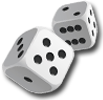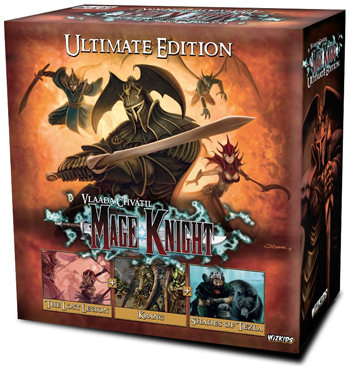



play board games
Board game reviews, strategy tips & session reports
Mage Knight Ultimate Edition Review
 Stats:
Stats:
No. of players: 1-5
Amount of time to play: 120-240 min
Age requirements: 14+
Set-up time: 10-15 min
Mage Knight Ultimate Edition combines the base game, all three expansions (The Lost Legion, Krang, and Shades of Tezla), and 5 new cards. The miniatures have alternate paint jobs from the original board game too.
Mage Knight Ultimate Edition Basic Rules Description:
Mage Knight is played out over a certain number of rounds (up to six) based on the scenario you play. Each round will alternate between day and night. After selecting your character and getting their sixteen card deck (with two character unique cards) the starting player draws a tactic card (numbered one to six) that matches the time (day or night). Then each player does the same. The tactic card will grant you a bonus as well as determine when you will act in the round.
After shuffling your deck you draw five cards into your hand, the starting player takes a turn and play proceeds clockwise. When you try to draw a card but there are none in your deck you will trigger the last turn of the round.
On your turn you may want to move around the map, attack monsters or visit a village or other location. To take these actions, you play cards from your hand and get the value they show for movement, attack, block, influence or other needed resources. For example, to move three hexes next to a monster (to attack it this turn or later), you might need nine total movement. This depends on the terrain of the hexes and the time of day/night. You can play a card with a four movement and one with a five, then move. But if you only had two cards with four movement there is another solution. You can play any card sideways to gain one point of any needed basic action no matter what is on the card. To finish your turn you discard any non-wound cards you’d like then draw back up to five.
In my example above we only moved a character, but you can move, attack and hire followers all on the same turn, if you have the cards to pay the costs those actions will take.
The card abilities are split into two sections. The top section shows its basic ability. But cards can be enhanced by playing them and spending mana. Then you use the bottom (more powerful) ability. You may gain mana from cards, hexes on the board or as treasure, but every turn you may use one mana dice from the pool for free.
Monsters are represented by cardboard tokens which show stats for their armor value, attack, and any special abilities they have. Combat is broken into phases. First you may make ranged/sieged attacks (this is not a basic action), if the total ranged/sieged attack value is not equal to or higher than the enemy survives and attacks you. In the next phase you block incoming damage using cards, armor, or units you command. If you cannot block the attack you gain wounds which are useless cards into your hand. You can wound units to avoid damage and even if you are hit, your armor will help reduce wounds. The last phase is when you attack the monster. Playing attack cards valued equal to or more than the monster’s armor value eliminates it.
Defeating enemies gains you fame which acts like experience and levels you up. Going up a level grants you the ability to gain one more follower and possibly increase your hand size and armor or gain a character specific skill and an advanced action card.
Your goal will differ based on the scenario and this rules description is just a basic overview. You should check out these videos for a more in-depth dive into Mage Knight’s rules. If at the end of the round if the goal was not met, you start the next round alternating between day and night.
Quick Review of Mage Knight Ultimate Edition:
Mage Knight Ultimate Edition is a great board game and is my favorite solitaire board game. This edition is awesome and includes everything released plus five new advanced action cards. If you have not played the game you need to realize there is a learning curve and that adding players adds time.
The components for the Ultimate Edition are great. Everything looks fantastic on the table and the miniatures are painted very well. The rules are well written but can sometimes be hard to reference. I highly suggest reading the rules, watching a few videos, and then playing the game with a search engine close by. After playing a couple times you should have the basics down.
One reason this game is so great is that each turn is a unique puzzle. You draw your hand and must figure out the best things you can accomplish given what you’ve drawn. There can be a few different answers and it isn’t always clear which is the best.
Like I said each turn is a puzzle and being able to use any card for a basic action makes for some flexible yet challenging decision making. Sometimes playing cards sideways means you’ll miss out on actions you’d like later that turn. But it is super satisfying figuring out how to get the most out of your cards and accomplish your goal for the turn.
Gaining fame and leveling up the characters is very fun too. It lets you take on later challenges in the game without getting overpowered. There is a sense of accomplishment defeating monsters and watching your character grow and gain more followers.
Mage Knight Ultimate Edition is a time commitment and I am not sure I’d play with more than two (maybe three if everyone was pretty experienced). There is a super easy dummy player making solo play easy.
The replay value of this game is fantastic too. You’ll want to try all the characters. The cards that come out from spells, to units or advanced actions, are different every game. This ensures a different experience every time. And that is before trying the different scenarios.
If you are looking for a fun, kinda-heavy solitaire board game, pick up Mage Knight Ultimate Edition. For players with the base set, if you play pick up this edition. If you have the base set and the Lost Legion expansion, it might depend how much you play. I really like how everything from the series is in this edition and plan to play it often.
Score and synopsis: (Click here for an explanation of these review categories.)
Strategy 5 out of 6
Luck 4 out of 6
Player Interaction (depends on the scenario)
Replay Value 6 out of 6
Complexity 5 out of 6
Fun 6 out of 6
Overall 6 out of 6

Leave a Reply